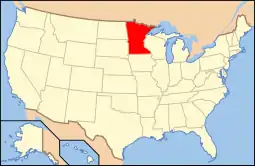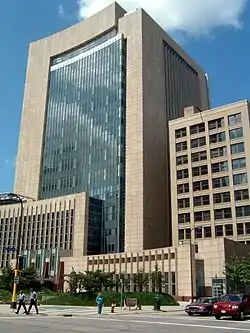United States District Court for the District of Minnesota
The United States District Court for the District of Minnesota (in case citations, D. Minn.) is the Federal district court whose jurisdiction is the state of Minnesota. Its two primary courthouses are in Minneapolis and Saint Paul. Cases are also heard in the federal courthouses of Duluth and Fergus Falls.
| United States District Court for the District of Minnesota | |
|---|---|
| (D. Minn.) | |
 | |
| Location | Minneapolis |
| Appeals to | Eighth Circuit |
| Established | May 11, 1858 |
| Judges | 7 |
| Chief Judge | John R. Tunheim |
| Officers of the court | |
| U.S. Attorney | Erica MacDonald |
| U.S. Marshal | Ramona L. Dohman |
| www | |
Appeals from the District of Minnesota are taken to the United States Court of Appeals for the Eighth Circuit (except for patent claims and claims against the U.S. government under the Tucker Act, which are appealed to the Federal Circuit).

United States Attorney
The United States Attorney's Office for the District of Minnesota represents the United States in civil and criminal litigation in the court. One notable former United States Attorney for the District was Cushman K. Davis who later went on to become governor of the state and was elected to the United States Senate.
Since May 2018, the current United States Attorney is Erica MacDonald.
Current judges
As of October 15, 2019:
| # | Title | Judge | Duty station | Born | Term of service | Appointed by | ||
|---|---|---|---|---|---|---|---|---|
| Active | Chief | Senior | ||||||
| 29 | Chief Judge | John R. Tunheim | Minneapolis | 1953 | 1995–present | 2015–present | — | Clinton |
| 33 | District Judge | Patrick J. Schiltz | Minneapolis | 1960 | 2006–present | — | — | G.W. Bush |
| 34 | District Judge | Susan Richard Nelson | Saint Paul | 1952 | 2010–present | — | — | Obama |
| 35 | District Judge | Wilhelmina Wright | Saint Paul | 1964 | 2016–present | — | — | Obama |
| 36 | District Judge | Eric C. Tostrud | Saint Paul | 1965 | 2018–present | — | — | Trump |
| 37 | District Judge | Nancy E. Brasel | Saint Paul | 1969 | 2018–present | — | — | Trump |
| 38 | District Judge | vacant | — | — | — | — | — | — |
| 20 | Senior Judge | Donald D. Alsop | Saint Paul | 1927 | 1974–1992 | 1985–1992 | 1992–present | Ford[Note 1] |
| 24 | Senior Judge | Paul A. Magnuson | Saint Paul | 1937 | 1981–2002 | 1994–2001 | 2002–present | Reagan |
| 26 | Senior Judge | David S. Doty | Minneapolis | 1929 | 1987–1998 | — | 1998–present | Reagan |
| 27 | Senior Judge | Richard H. Kyle | inactive | 1937 | 1992–2005 | — | 2005–present | G.H.W. Bush |
| 28 | Senior Judge | Michael J. Davis | Minneapolis | 1947 | 1994–2015 | 2008–2015 | 2015–present | Clinton |
| 30 | Senior Judge | Ann D. Montgomery | Minneapolis | 1949 | 1996–2016 | — | 2016–present | Clinton |
| 31 | Senior Judge | Donovan W. Frank | Saint Paul | 1951 | 1998–2016 | — | 2016–present | Clinton |
| 32 | Senior Judge | Joan N. Ericksen | Minneapolis | 1954 | 2002–2019 | — | 2019–present | G.W. Bush |
- Judge Alsop was nominated by President Nixon but was appointed to the Court by (i.e., received his commission from) President Ford.
Vacancies and pending nominations
| Seat | Prior Judge's Duty Station | Seat last held by | Vacancy reason | Date of vacancy | Nominee | Date of nomination |
|---|---|---|---|---|---|---|
| 1 | Minneapolis | Joan N. Ericksen | Senior status | October 15, 2019 | – | – |
Former judges
| # | Judge | State | Born–died | Active service | Chief Judge | Senior status | Appointed by | Reason for termination |
|---|---|---|---|---|---|---|---|---|
| 1 | Rensselaer Nelson | MN | 1826–1904 | 1858–1896 | — | — | Buchanan | retirement |
| 2 | William Lochren | MN | 1832–1912 | 1896–1908 | — | — | Cleveland | retirement |
| 3 | Page Morris | MN | 1853–1924 | 1903–1923 | — | 1923–1924 | T. Roosevelt | death |
| 4 | Milton D. Purdy | MN | 1866–1937 | 1908–1909[Note 1] 1909[Note 2] |
— | — | T. Roosevelt Taft |
not confirmed resignation |
| 5 | Charles Andrew Willard | MN | 1857–1914 | 1909–1914 | — | — | Taft | death |
| 6 | Wilbur F. Booth | MN | 1861–1944 | 1914–1925 | — | — | Wilson | elevation to 8th Cir. |
| 7 | John F. McGee | MN | 1861–1925 | 1923–1925 | — | — | Harding | death |
| 8 | William Alexander Cant | MN | 1863–1933 | 1923–1933[Note 3] | — | — | Harding[Note 4] Coolidge[Note 5] |
death |
| 9 | Joseph W. Molyneaux | MN | 1859–1940 | 1925–1937 | — | 1937–1940 | Coolidge | death |
| 10 | John B. Sanborn Jr. | MN | 1883–1964 | 1925–1932 | — | — | Coolidge | elevation to 8th Cir. |
| 11 | Gunnar Nordbye | MN | 1888–1977 | 1931–1967[Note 6] | 1948–1959 | 1967–1977 | Hoover | death |
| 12 | Matthew M. Joyce | MN | 1877–1956 | 1932–1954 | — | 1954–1956 | Hoover | death |
| 13 | Robert Cook Bell | MN | 1880–1964 | 1933–1961 | — | 1961–1964 | F. Roosevelt | death |
| 14 | George F. Sullivan | MN | 1886–1944 | 1937–1944 | — | — | F. Roosevelt | death |
| 15 | Dennis F. Donovan | MN | 1889–1974 | 1945–1965 | — | 1965–1974 | Truman | death |
| 16 | Edward Devitt | MN | 1911–1992 | 1954–1981[Note 7] | 1959–1981 | 1981–1992 | Eisenhower | death |
| 17 | Earl R. Larson | MN | 1911–2001 | 1961–1977 | — | 1977–2001 | Kennedy | death |
| 18 | Miles Lord | MN | 1919–2016 | 1966–1985 | 1981–1985 | 1985 | L. Johnson | retirement |
| 19 | Philip Neville | MN | 1909–1974 | 1967–1974 | — | — | L. Johnson | death |
| 21 | Harry H. MacLaughlin | MN | 1927–2005 | 1977–1992 | 1992 | 1992–2005 | Carter | death |
| 22 | Diana E. Murphy | MN | 1934–2018 | 1980–1994 | 1992–1994 | — | Carter | elevation to 8th Cir. |
| 23 | Robert G. Renner | MN | 1923–2005 | 1980–1992 | — | 1992–2005 | Carter | death |
| 25 | James M. Rosenbaum | MN | 1944–present | 1985–2009 | 2001–2008 | 2009–2010 | Reagan | retirement |
- Recess appointment; the United States Senate later rejected the appointment.
- Received a second recess appointment but resigned prior to consideration.
- Recess appointment; formally nominated on December 15, 1923, confirmed by the Senate on January 15, 1924, and received commission the same day.
- Judge Cant was given a recess appointment by President Harding.
- Judge Cant was nominated by President Harding but was appointed to the Court by (i.e., received his commission from) President Coolidge.
- Recess appointment; formally nominated on December 16, 1931, confirmed by the Senate on February 3, 1932, and received commission on February 10, 1932.
- Recess appointment; formally nominated on January 10, 1955, confirmed by the Senate on February 4, 1955, and received commission on February 7, 1955.
Chief judges
Chief judges have administrative responsibilities with respect to their district court. Unlike the Supreme Court, where one justice is specifically nominated to be chief, the office of chief judge rotates among the district court judges. To be chief, a judge must have been in active service on the court for at least one year, be under the age of 65, and have not previously served as chief judge. A vacancy is filled by the judge highest in seniority among the group of qualified judges. The chief judge serves for a term of seven years or until age 70, whichever occurs first. The age restrictions are waived if no members of the court would otherwise be qualified for the position.
When the office was created in 1948, the chief judge was the longest-serving judge who had not elected to retire on what has since 1958 been known as senior status or declined to serve as chief judge. After August 6, 1959, judges could not become or remain chief after turning 70 years old. The current rules have been in operation since October 1, 1982.
Succession of seats
|
|
|
|
| ||||||||||||||||||||||||||||||||||||||||||||||||||||||||||||||||||||||||||||||||||||||||
|
|
|
|
| ||||||||||||||||||||||||||||||||||||||||||||||||||||||||||||
